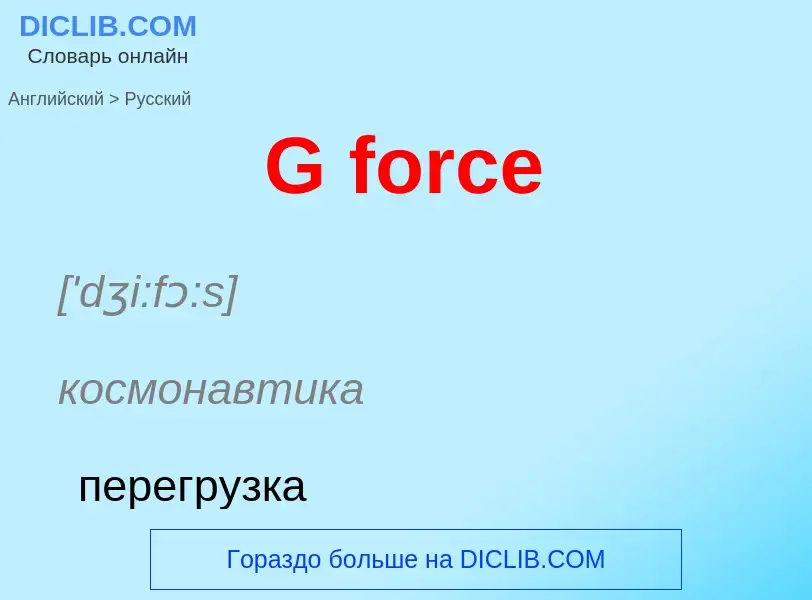Tradução e análise de palavras por inteligência artificial ChatGPT
Nesta página você pode obter uma análise detalhada de uma palavra ou frase, produzida usando a melhor tecnologia de inteligência artificial até o momento:
- como a palavra é usada
- frequência de uso
- é usado com mais frequência na fala oral ou escrita
- opções de tradução de palavras
- exemplos de uso (várias frases com tradução)
- etimologia
G force - tradução para russo
['dʒi:fɔ:s]
космонавтика
перегрузка
[dʒi:]
общая лексика
(giga-) префикс гига-
обозначает 1 миллиард, или 109. В вычислительной технике G означает 230, или 1 073 741 824
сокращение
[gas] газ
газовый
Смотрите также
существительное
общая лексика
7-я буква английского алфавита
музыка
соль (G)
космонавтика
перегрузка
сленг
тысяча долларов (G.) ([сокр.] от grand)
Смотрите также
Definição
Wikipédia
The gravitational force equivalent, or, more commonly, g-force, is a measurement of the type of force per unit mass – typically acceleration – that causes a perception of weight, with a g-force of 1 g (not gram in mass measurement) equal to the conventional value of gravitational acceleration on Earth, g, of about 9.8 m/s2. Since g-forces indirectly produce weight, any g-force can be described as a "weight per unit mass" (see the synonym specific weight). When the g-force is produced by the surface of one object being pushed by the surface of another object, the reaction force to this push produces an equal and opposite weight for every unit of each object's mass. The types of forces involved are transmitted through objects by interior mechanical stresses. Gravitational acceleration (except certain electromagnetic force influences) is the cause of an object's acceleration in relation to free fall.
The g-force experienced by an object is due to the vector sum of all non-gravitational forces acting on an object's freedom to move. In practice, as noted, these are surface-contact forces between objects. Such forces cause stresses and strains on objects, since they must be transmitted from an object surface. Because of these strains, large g-forces may be destructive.
Gravity acting alone does not produce a g-force, even though g-forces are expressed in multiples of the free-fall acceleration of standard gravity. Thus, the standard gravitational force at the Earth's surface produces g-force only indirectly, as a result of resistance to it by mechanical forces. It is these mechanical forces that actually produce the g-force on a mass. For example, a force of 1 g on an object sitting on the Earth's surface is caused by the mechanical force exerted in the upward direction by the ground, keeping the object from going into free fall. The upward contact force from the ground ensures that an object at rest on the Earth's surface is accelerating relative to the free-fall condition. (Free fall is the path that the object would follow when falling freely toward the Earth's center). Stress inside the object is ensured from the fact that the ground contact forces are transmitted only from the point of contact with the ground.
Objects allowed to free-fall in an inertial trajectory under the influence of gravitation only feel no g-force, a condition known as weightlessness. This is also termed "zero-g", although the more correct term is "zero g-force". This is demonstrated by the zero g-force conditions inside an elevator falling freely toward the Earth's center (in vacuum), or (to good approximation) conditions inside a spacecraft in Earth orbit. These are examples of coordinate acceleration (a change in velocity) without a sensation of weight.
In the absence of gravitational fields, or in directions at right angles to them, proper and coordinate accelerations are the same, and any coordinate acceleration must be produced by a corresponding g-force acceleration. An example here is a rocket in free space, in which simple changes in velocity are produced by the engines and produce g-forces on the rocket and passengers.

![0}} in 0.86 seconds. This is a horizontal acceleration of 5.3 g. Combining this with the vertical g-force in the stationary case using the [[Pythagorean theorem]] yields a g-force of 5.4 g. 0}} in 0.86 seconds. This is a horizontal acceleration of 5.3 g. Combining this with the vertical g-force in the stationary case using the [[Pythagorean theorem]] yields a g-force of 5.4 g.](https://commons.wikimedia.org/wiki/Special:FilePath/Nitrolympics TopFuel 2005.jpg?width=200)
![This [[acrobatic airplane]] is pulling up in a +g maneuver; the pilot is experiencing several g's of inertial acceleration in addition to the force of gravity. The cumulative vertical axis forces acting upon his body make him momentarily 'weigh' many times more than normal. This [[acrobatic airplane]] is pulling up in a +g maneuver; the pilot is experiencing several g's of inertial acceleration in addition to the force of gravity. The cumulative vertical axis forces acting upon his body make him momentarily 'weigh' many times more than normal.](https://commons.wikimedia.org/wiki/Special:FilePath/Red.bull.air.race.arp.750pix.jpg?width=200)
![The [[Superman: Escape from Krypton]] roller coaster at [[Six Flags Magic Mountain]] provides 6.5 seconds of ballistic weightlessness. The [[Superman: Escape from Krypton]] roller coaster at [[Six Flags Magic Mountain]] provides 6.5 seconds of ballistic weightlessness.](https://commons.wikimedia.org/wiki/Special:FilePath/Superman Escape from Krypton tower.jpg?width=200)
